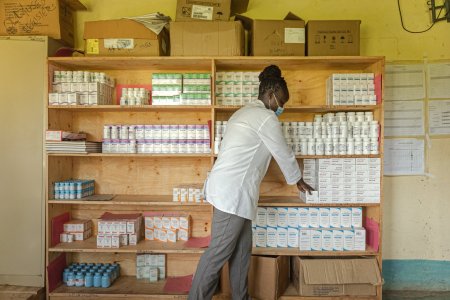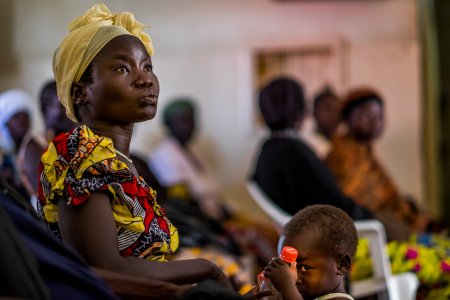
About the possibility of controlling an HIV epidemic hotspot
Elba Rahmouni, Pierre Mendiharat & Léon Salumu Luzinga

Since April 2018, Elba has been in charge of dissemination at CRASH. Elba holds a Master's degree in History of Classical Philosophy and a Master's degree in editorial consulting and digital knowledge management. During her studies, she worked on moral philosophy issues and was particularly interested in the practical necessity and the moral, legal and political prohibition of lying in Kant's philosophy.
Responsable des programmes à Médecins Sans Frontières, Centre opérationnel de Paris (OCP)
This article was first released in the 18th volume of the Humanitarian Alternatives magazine.
Designed to reduce the incidence of HIV/AIDS in a Kenyan district, a Médecins Sans Frontières project successfully exceeded the “90-90-90” target set by UNAIDS. A look back on the results that the authors of this article - Pierre Mendiharat, Deputy director of operations at MSF France and Léon Salumu Luzinga, Program manager at MSF France, interviewed by Elba Rahmouni - believe are encouraging but by no means a guarantee that the epidemic will be over by 2030.
Despite strong international mobilisation over the last decades that has enabled significant advances in the fight against the human immunodeficiency virus/acquired immunodeficiency syndrome (HIV/AIDS), the disease continues to kill on a massive scale, as is the case in Kenya, in the rural district of Ndhiwa in the county of Homa Bay.Kenya has been composed of forty-seven counties, each divided into districts, since the decentralisation of power introduced by the new constitution adopted in 2010. The ancient province of Nyanza, situated on the shore of Lake Victoria in the southwest of Kenya, includes the county of Homa Bay, itself divided into eight districts, including the district of Ndhiwa.Although there is still no definite treatment or vaccine, the Joint United Nations Programme on HIV/AIDS (UNAIDS) has set itself the ambitious goal of ending the HIV/AIDS epidemic by 2030, in particular through the implementation of the strategy known as the “90-90-90” target (or “treatment cascade”): 90% of all people living with HIV should know their HIV status, 90% of all people with diagnosed HIV infection should receive sustained antiretroviral therapy (ART) and 90% of all people receiving ART should have viral suppression. These bold claims were put to the test in a five-year programme launched in 2014 by Doctors Without Borders (Médecins sans frontières – MSF) and Kenya’s Ministry of Health in the district of Ndhiwa. Previously, the Ndhiwa HIV Impact in Population Survey 1 (NHIPS 1) conducted by Épicentre (MSF’s epidemiology centre) in 2012 had brought to light HIV incidence and prevalence figures amongst the highest in the world. Six years later, a new Épicentre study, NHIPS 2 Médecins Sans Frontières, VIH : l’amélioration de la prise en charge a fait chuter la proportion des personnes infectées dans l’un des foyers les plus touchés au monde, 24 novembre 2020, https://www.msf.fr/communiques-presse/vih-l-amelioration-de-la-prise-en-charge-a-fait-chuter-la-proportion-des-personnes-infectees-dans-l-un-des-foyers-les-plus, demonstrated that the “90-90-90” target had been exceeded. With incidence in significant decline, yet still elevated, can this truly be considered a success?
To cite this content :
Elba Rahmouni, Pierre Mendiharat, Léon Salumu Luzinga, “About the possibility of controlling an HIV epidemic hotspot”, 14 novembre 2021, URL : https://msf-crash.org/en/medicine-and-public-health/about-possibility-controlling-hiv-epidemic-hotspot
If you would like to comment on this article, you can find us on social media or contact us here:
ContributeLes représentations du VIH et leur impact sur le recours aux soins. Enquête au sein de la population masculine de Homa Bay au Kenya
12/12/2018 Jean-Hervé BradolXavier Plaisancie est médecin. Dans cette vidéo réalisée par la revue Alternatives Humanitaires, il présente sa thèse intitulée : « Les représentations du VIH et leur impact sur le recours aux soins. Enquête au sein de la population masculine de Homa Bay au Kenya. », un travail de recherche pour lequel il a été accompagné par Jean-Hervé Bradol et Marc Le Pape du CRASH.
 Njiiri Karago/MSF
Analysis
Njiiri Karago/MSF
Analysis
What AIDS teaches us
09/16/2022 Rony BraumanIn this article, Rony Brauman identifies the dynamics and events that made bending the HIV/AIDS epidemic curve possible. He explains the climate in which the tug-of-war with parts of the pharmaceutical industry played out from MSF’s perspective, and recalls that fears about international security and political stability also helped push governments to mobilise against the epidemic.
 Isabel Corthier
Cahier
Isabel Corthier
Cahier
AIDS: A new pandemic leading to new medical and political practices
12/15/2011 Joan Amondi Jean-Hervé Bradol Vanja Kovacic Elisabeth SzumilinIt seemed appropriate to assemble these texts now, at a time when the history of our AIDS missions is compelling us to formulate new goals.
Période
Newsletter
Subscribe to our newsletter to stay informed about our latest publications. Interested in a specific author or thematic? Subscribe to our email alerts.
